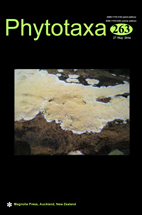Abstract
Interspecific phylogenetic relationships in the Neotropical orchid genus Mormodes were assessed by means of maximum parsimony (MP) and Bayesian inference (BI) analyses of non-coding nuclear ribosomal (nrITS) and plastid (trnL–trnF) DNA sequences and 24 morphological characters for 36 species of Mormodes and seven additional outgroup species of Catasetinae. The bootstrap (>50%) consensus trees of the MP analyses of each separate dataset differed in the degree of resolution and overall clade support, but there were no contradicting groups with strong bootstrap support. MP and BI combined analyses recovered similar relationships, with the notable exception of the BI analysis not resolving section Mormodes as monophyletic. However, sections Coryodes and Mormodes were strongly and weakly supported as monophyletic by the MP analysis, respectively, and each has diagnostic morphological characters and different geographical distribution. The geographic structure reflected by the recovered phylogenetic patterns suggests that it is possible to undertake taxonomic revision of regional clades, which eventually will lead to a thorough revision of the genus.

